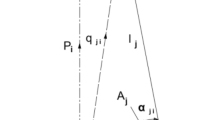Abstract
This paper studies the laser vision-based automatic trajectory planning technology for spatial intersecting joint weld. Firstly, the mathematical model of T-type off-axis non-groove intersecting joint is established, and the welding seam characteristics of the intersecting joint are analyzed. Secondly, a triangular pseudo-rotation feature pixel detection algorithm based on monocular structured light vision is proposed to realize the rapid extraction and location of spatial intersecting joint weld. Then, a laser vision-based calibration method for the workpiece coordinate system of the T-type intersecting joint is proposed, the relationship between intersecting joint workpiece coordinate system and robot base coordinate system is established, and the trajectory equation is obtained. At last, a searching discrete of chord error interpolation control algorithm is proposed to automatically discrete and plan welding torch gesture data. Experiments show that the technology can achieve higher precision location and better intersecting joint weld trajectory planning, and realize high-quality automatic weld of intersecting joint.















Similar content being viewed by others
References
Gao, F. Q. (2016). Vision-based curve tracking system using fuzzy controller. Control Engineering of China,23(1), 149–152.
Lü, X. Q., Zhang, K., & Wu, Y. X. (2003). Condition and expectation of automatic weld seam tracking. Journal of Mechanical Engineering,39(12), 80–85.
Madsen, O., Sørensen, C. B., Larsen, R., et al. (2002). A system for complex robotic welding. Industrial Robot,29(29), 127–131.
Lei, Z. L., Lv, T., Chen, Y. B., et al. (2013). Features extraction for weld image of scanning laser sensing. Transactions of the China Welding Institution,35(5), 54–58.
Zou, Y., Zhou, W., & Wang, Y. (2017). Laser Vision seam automatic tracking based on probability continuous model. Journal of Mechanical Engineering,53(10), 70–78.
Liu, X. (2017). Application of image processing and multi-sensor information fusion in pipeline intersecting line weld seam detection robot. Dissertation. Guangdong. Shenzhen University, 2017.
Yang, P., Xu, B. S., Wu L., et al. (2005) Space weld positioning system of arc welding robot based on structured light stereo vision. In Proceedings of the Eleventh National Welding Conference (Vol. 2).
Chen, X., Dharmawan, A. G., Foong, S., et al. (2018). Seam tracking of large pipe structures for an agile robotic welding system mounted on scaffold structures. Robotics and Computer-Integrated Manufacturing,50, 242–255.
Yan, K. (2018). Research on intersecting curve welding robot system based on laser vision. Dissertation. Shandong University, 2018.
Ahmed, S. M., Tan, Y. Z., Lee G. H., et al. (2016) Object detection and motion planning for automated welding of tubular joints. In IEEE/RSJ International Conference on Intelligent Robots and Systems (pp. 2610–2615). IEEE.
Zhou, Y., Chen, X., Gong, G., et al. (2018). A seam tracking system based on a laser vision sensor. Measurement,127, 489–500.
Wang, T. Q. (2015). Research on KY space welding robot system of offshore platform jacket. Dissertation. Tianjin Polytechnic University, 2015.
Wang, K. H., Liu, Y., & Yu, J. (2003). Study of geometric model and attitude of typical workpiece welded in robot. Electric Welding Machine,33(6), 29–32.
Zhang, Y., Zhang, X., & Luo, Y. (2015). Trajectory planning for irregular intersecting line of two pipes. Wuhan: Huazhong Univ. of Sci. &. Tech. (Natural Science Edition).
Wu, L., & Kong, Y. (1997). Definition and geometric model of welding position and torch orientation. Journal of Mechanical Engineering,33(5), 49–53.
Masatoshi, H., Akira, O., & Toshihiko, N. (2007). Development of automatic welding system for crawler crane latticed booms. R & D Kobe Steel Technology News,27, 53–57.
Zhou, L., & Chen, S. B. (2009). Breaking branches algorithm and its application in welding image processing. Journal of Mechanical Engineering,45(03), 282–285.
Miao, X. G., Wang, S., & Li, X. H. (2011). Method of track fitting on big frame intersection line seam. Transactions of the China Welding Institution,32(1), 89–92.
Zhang, H., Chen, F. X., Chen, C. M., et al. (2013). On skew lines. Studies in College Mathematics,16(02), 40–42.
Kang, S. J. (2007). Research on NURBS real time interpolation. Dissertation. Nanjing University of Aeronautics and Astronautics.
Xu, H. Y., & Dai, J. S. (2002). Three-dimensional implicit curve interpolation. International Journal of Advanced Manufacturing Technology,19(5), 325–329.
Yuan, C., Zhang, K., & Fan, W. (2013). Time-optimal interpolation for CNC machining along curved tool paths with confined chord error. Journal of Systems Science and Complexity,26(5), 836–870.
Básaca-Preciado, L. C., Sergiyenko, O. Y., Rodríguez-Quinonez, J. C., et al. (2014). Optical 3D laser measurement system for navigation of autonomous mobile robot. Optics and Lasers in Engineering,54, 159–169.
Garcia-Cruz, X. M., Sergiyenko, O. Y., Tyrsa, V., et al. (2014). Optimization of 3D laser scanning speed by use of combined variable step. Optics and Lasers in Engineering,54, 141–151.
Fu, X. L. (2015) Research on the trajectory and welding procedure of pipe-pipe intersecting line welding by robot. Doctoral dissertation. Shanghai University of Engineering Science, 2015.
Li, D. J., Li, Q., Wang, S. W., et al. (2018). Design of new welding torch for automatic welding of all position intersecting line. Transactions of the China Welding Institution, 39(3), 117–119, 123.
Acknowledgements
This work is financially supported by National Natural Science Foundation of China (Grant No. U1733125), Natural Science Foundation of Tianjin (Grant No. 18JCYBJC18700) and Natural Science Foundation of Tianjin (Grant No. 18JCYBJC19100).
Author information
Authors and Affiliations
Corresponding author
Additional information
Publisher's Note
Springer Nature remains neutral with regard to jurisdictional claims in published maps and institutional affiliations.
Rights and permissions
About this article
Cite this article
Jia, Z., Wang, T., Li, L. et al. Laser Vision-Based Automatic Trajectory Planning Technology for Spatial Intersecting Joint Weld. Int. J. Precis. Eng. Manuf. 21, 45–55 (2020). https://doi.org/10.1007/s12541-019-00248-0
Received:
Revised:
Accepted:
Published:
Issue Date:
DOI: https://doi.org/10.1007/s12541-019-00248-0




